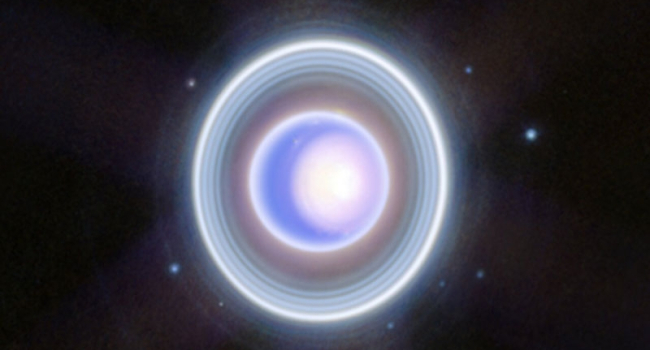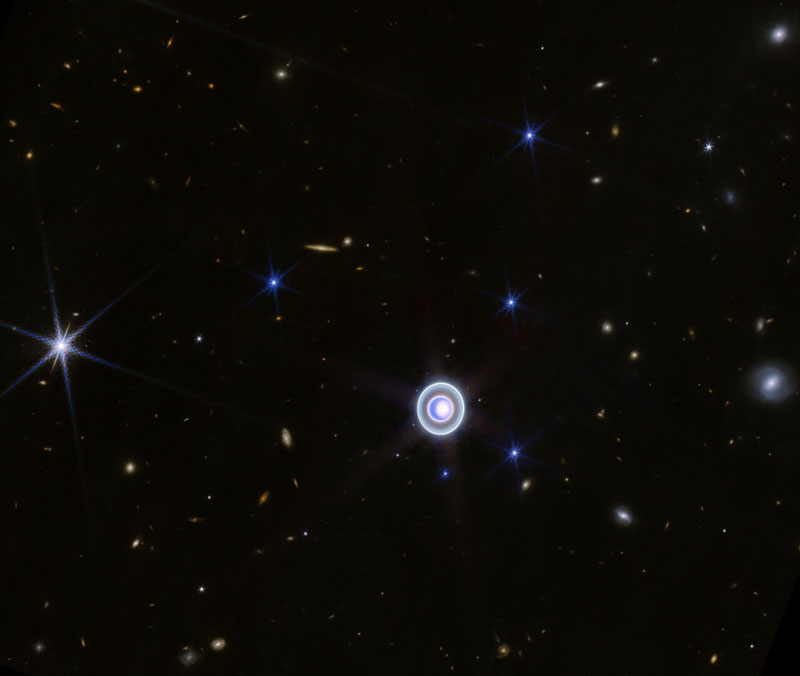
James Webb takes colorful and detailed photo of Uranus and its surroundings
The European Space Agency, which, like NASA, is involved in the operation of the James Webb Space Telescope, has shared a new image of Uranus and its surroundings taken with the telescope's near-infrared camera featuring four different wavelength bands.
Uranus and its moons are not the most convenient objects to photograph with telescopes. Their constant motion makes it challenging to capture long-exposure shots, leading to a loss of valuable scientific details. However, computer processing and assembling frames with different exposure times help produce stunning and detailed results.

The new image stands out for its brightness and rich detail. Unlike earlier images of Uranus captured by Webb's NIRCam in wavelengths of 1.4 and 3.0 micrometers earlier this year, the new image includes two additional wavelength ranges: 2.1 and 4.6 micrometers. The Webb telescope's sensitive sensors enabled the detection of even the faint inner ring.
A prominent feature on the planet is the bright area, identified as the northern polar cap or, more precisely, an aerosol suspension in the atmosphere in the form of ice crystals made of water, methane, and other substances. This area is also subject to an active polar cyclone, observed for the first time this year. The Webb images reveal atmospheric swirls around the edges of the cyclone, providing insights into atmospheric processes.
As the image of Uranus was taken with a wide-angle view, it includes 14 out of the 27 largest moons. Additionally, some galaxies appear in the frame as pink and white spirals and spindles.
- Related News
- Wheel of Death: new method will help astronauts stay fit in low gravity
- Due to anomalies of Orion spacecraft, lunar exploration program may be delayed for years։ NASA
- TAO Observatory: World's highest telescope to study evolution of galaxies and exoplanets
- Powerful M9.5 solar flare causes radio blackout in Pacific Ocean
- What will happen to the Earth if the Moon disappears?
- Key to conquering the Red Planet: Why is NASA studying solar storms on Mars?
- Most read
month
week
day
- Digital Julfa Network is launching a pan-Armenian centre in the metaverse, on the Fastexverse virtual platform 920
- Xiaomi unveils exclusive Redmi Note 13 Pro+ dedicated to Messi and Argentina national team 812
- Sparkles: Boston Dynamics unveils a furry robot dog that can dance (video) 801
- Is there a ninth planet in the solar system? Scientists find new evidence 678
- Smartphone catches fire in child's hand in Russia 658
- What will happen to the Earth if the Moon disappears? 654
- How to understand how protected a smartphone is from water and dust? 639
- World's largest 3D printer was created in USL It prints 29 meter-long structures 623
- iPhone 16 may get colored matte glass back panel, 7 colors 620
- New iPad Pro to receive M4 chip and to be more powerful than Apple computers 613
- Archive
